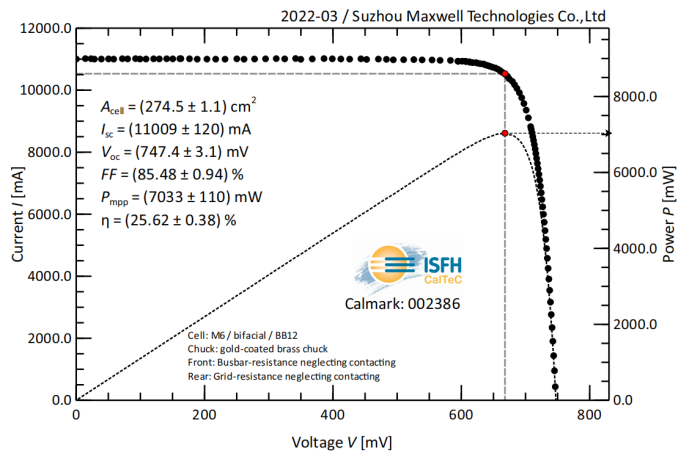Recently, certified by the Institute for Solar Energy Research (ISFH) in Hamelin, Germany, an authoritative testing institution in Germany, Maxwell has achieved a photoelectric conversion efficiency of 25.62% on full size (M6, 274.5cm²) HJT cell via using low-indium transparent conductive oxides (TCO) combined with silver-coated copper paste, creating a new world record.
This latest technology ensures considerably high efficiency for HJT solar cells in mass production and significant cost reduction. The 144-half-size-M6-cells HJT module developed by Maxwell's module technology laboratory using this batch of cells have been tested, and the power is 491.8W, which is 30W higher than that of PERC of the same size. The primary reference cells are from TÜV Rheinland, Germany.

Compared to previous cases, the use of indium in cell is reduced by 50% through the latest low-indium solution which adopts magnetron sputtering. Another 40% reduction can be reached as the indium decrease equipment is added, which reduces the amount of indium to 30% of the current level. In addition, the consumption of silver can be lowered by 55% through the silver-coated copper paste. Therefore, the combination of these two processes alone will dramatically cut back the manufacturing costs of HJT solar cells.
The module technology laboratory of Maxwell can independently complete the manufacturing and electrical performance testing of high-efficiency HJT modules, which plays an important role in module reliability assessment and process optimization. This batch of test cells uses SMBB(Super Multi Bus Bar) stringer and the special water-blocking encapsulation process that optimizes the soldering quality and mechanical damage, so the efficiency of the cells increases to 22.62%, equivalent to the highest efficiency of HJT modules with conventional precious metal content. In short, this batch of test modules achieve excellent efficiency and power while reducing the use of indium and silver and cutting the cost.
To promote the mass production and application of HJT technology, Maxwell continues to develop cost-efficient solutions for halving and thinning N-type silicon wafers and decreasing the use of silver paste and precious metals. At the same time, Maxwell is stepping up efforts to improve the mass production efficiency of HJT solar cells and modules through micro-crystallization, metallization, SMBB technology, and light conversion technology, and so on.
The latest technological breakthrough of Maxwell represents a feasible solution for the cost reduction and efficiency increase of HJT products in the photovoltaic industry. It will significantly accelerate the industrialization of HJT solar cells and modules and help reduce the LCOE of solar power and reach the goals of carbon peaking and carbon neutrality.